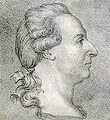Template:Selected anniversaries/April 17: Difference between revisions
No edit summary |
No edit summary |
||
| Line 1: | Line 1: | ||
<gallery> | <gallery> | ||
|| *** DONE: Pics *** | |||
||485: Proclus dies ... mathematician and philosopher. Pic search good. | ||485: Proclus dies ... mathematician and philosopher. Pic search good. | ||
| Line 52: | Line 54: | ||
||1974: Hugh Stott Taylor dies ... chemist primarily interested in catalysis. In 1925, in a landmark contribution to catalytic theory, Taylor suggested that a catalyzed chemical reaction is not catalysed over the entire solid surface of the catalyst but only at certain 'active sites' or centers. He also developed important methods for procuring heavy water during World War II and pioneered the use of stable isotopes in studying chemical reactions. Pic search good: https://www.google.com/search?q=hugh+stott+taylor | ||1974: Hugh Stott Taylor dies ... chemist primarily interested in catalysis. In 1925, in a landmark contribution to catalytic theory, Taylor suggested that a catalyzed chemical reaction is not catalysed over the entire solid surface of the catalyst but only at certain 'active sites' or centers. He also developed important methods for procuring heavy water during World War II and pioneered the use of stable isotopes in studying chemical reactions. Pic search good: https://www.google.com/search?q=hugh+stott+taylor | ||
||1976: Henrik Dam dies ... biochemist and physiologist, Nobel Prize laureate. | ||1976: Henrik Dam dies ... biochemist and physiologist, Nobel Prize laureate. Pic. | ||
||1977: Richard Dagobert Brauer dies ... mathematician. He worked mainly in abstract algebra, but made important contributions to number theory. He was the founder of modular representation theory. | ||1977: Richard Dagobert Brauer dies ... mathematician. He worked mainly in abstract algebra, but made important contributions to number theory. He was the founder of modular representation theory. Pic. | ||
File:Curt Meyer.jpg|link=Curt Meyer (nonfiction)|1978: Mathematician and crime-fighter [[Curt Meyer (nonfiction)|Curt Meyer]] publishes an alternative solution to the class number 1 problem which uses [[Gnomon algorithm functions]] to detect and erase the [[Forbidden Ratio]]. | File:Curt Meyer.jpg|link=Curt Meyer (nonfiction)|1978: Mathematician and crime-fighter [[Curt Meyer (nonfiction)|Curt Meyer]] publishes an alternative solution to the class number 1 problem which uses [[Gnomon algorithm functions]] to detect and erase the [[Forbidden Ratio]]. | ||
| Line 64: | Line 66: | ||
File:Piet Hein and H.C. Andersen.jpg|link=Piet Hein (nonfiction)|1996: Mathematician, author, and poet [[Piet Hein (nonfiction)|Piet Hein]] dies. He proposed the use of superellipses in architecture; superellipses subsequently became the hallmark of modern Scandinavian architecture. | File:Piet Hein and H.C. Andersen.jpg|link=Piet Hein (nonfiction)|1996: Mathematician, author, and poet [[Piet Hein (nonfiction)|Piet Hein]] dies. He proposed the use of superellipses in architecture; superellipses subsequently became the hallmark of modern Scandinavian architecture. | ||
||2007: Horace Richard Crane dies ... physicist, the inventor of the Race Track Synchrotron, a recipient of President Ronald Reagan's National Medal of Science "for the first measurement of the magnetic moment and spin of free electrons and positrons". He was also noted for proving the existence of neutrinos. | ||2007: Horace Richard Crane dies ... physicist, the inventor of the Race Track Synchrotron, a recipient of President Ronald Reagan's National Medal of Science "for the first measurement of the magnetic moment and spin of free electrons and positrons". He was also noted for proving the existence of neutrinos. Pic search yes: https://www.google.com/search?q=Horace+Richard+Crane | ||
||2012: Stephen James Rallis dies ... mathematician who worked on group representations, automorphic forms, the Siegel–Weil formula, and Langlands L-functions. Pic. | ||2012: Stephen James Rallis dies ... mathematician who worked on group representations, automorphic forms, the Siegel–Weil formula, and Langlands L-functions. Pic. | ||
Revision as of 14:19, 16 April 2019
1598: Priest and astromomer Giovanni Battista Riccioli born. He will experiment with pendulums and falling bodies, discuss arguments concerning the motion of the Earth, and introduce the current scheme of lunar nomenclature.
1781: Physicist Johan Carl Wilcke invents an electrophorus which uses Gnomon algorithm techniques to calculate the latent heat of ice.
1901: Electrical engineer, physicist, and engineer John Ambrose Fleming publishes new class of Gnomon algorithm functions which use thermionic valves to detect and prevent crimes against physical constants.
1915: Physicist, engineer, and alleged time-traveller Albert Einstein makes radio contact with orbital artificial intelligence AESOP.
1938: Philosopher and author Kerry Wendell Thornley born. In 1962 he will write a manuscript, The Idle Warriors, about his aquaintence Lee Harvey Oswald.
1961: Bay of Pigs Invasion: A group of Cuban exiles financed and trained by the CIA lands at the Bay of Pigs in Cuba with the aim of ousting Fidel Castro.
1968: Industrialist, motivational speaker, and alleged crime boss Colonel Zersetzung takes possession of a large quantity of military-grade Clandestiphrine.
1969: Sirhan Sirhan is convicted of assassinating Robert F. Kennedy.
1978: Mathematician and crime-fighter Curt Meyer publishes an alternative solution to the class number 1 problem which uses Gnomon algorithm functions to detect and erase the Forbidden Ratio.
1996: Mathematician, author, and poet Piet Hein dies. He proposed the use of superellipses in architecture; superellipses subsequently became the hallmark of modern Scandinavian architecture.
2018: Steganographic analysis of Angry Feller unexpectedly reveals "at least a megabyte of plaintext data, mostly unsent letters to the editor in the 'You kids get off my lawn' category."









